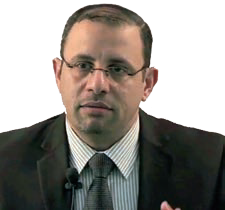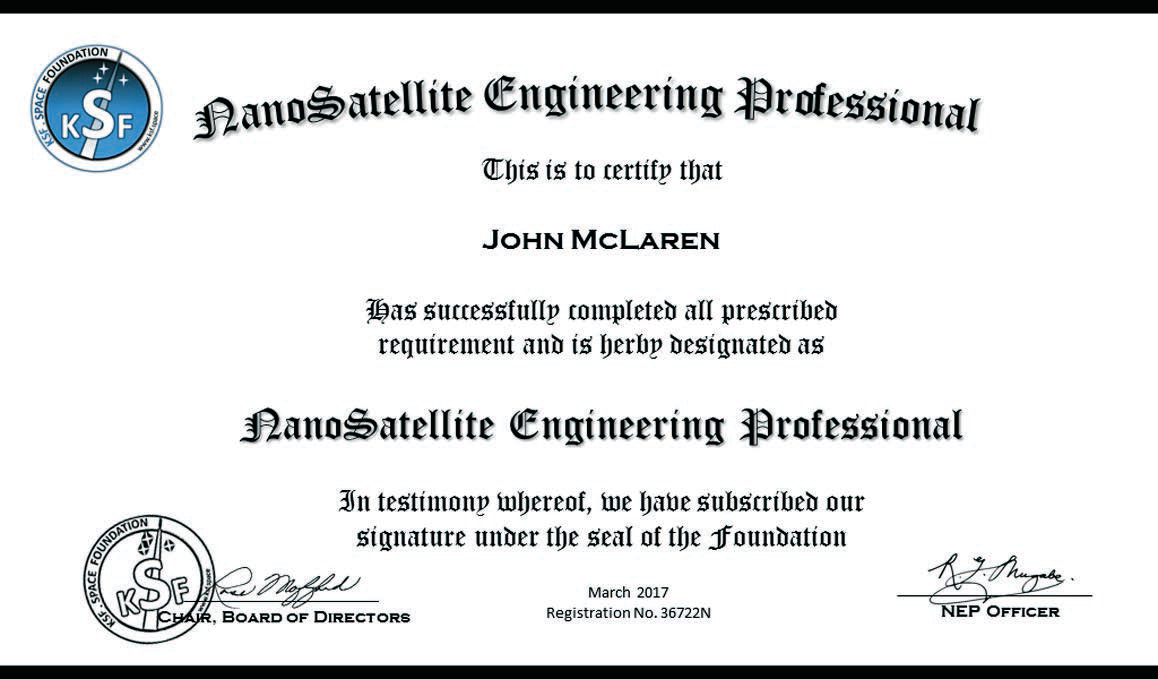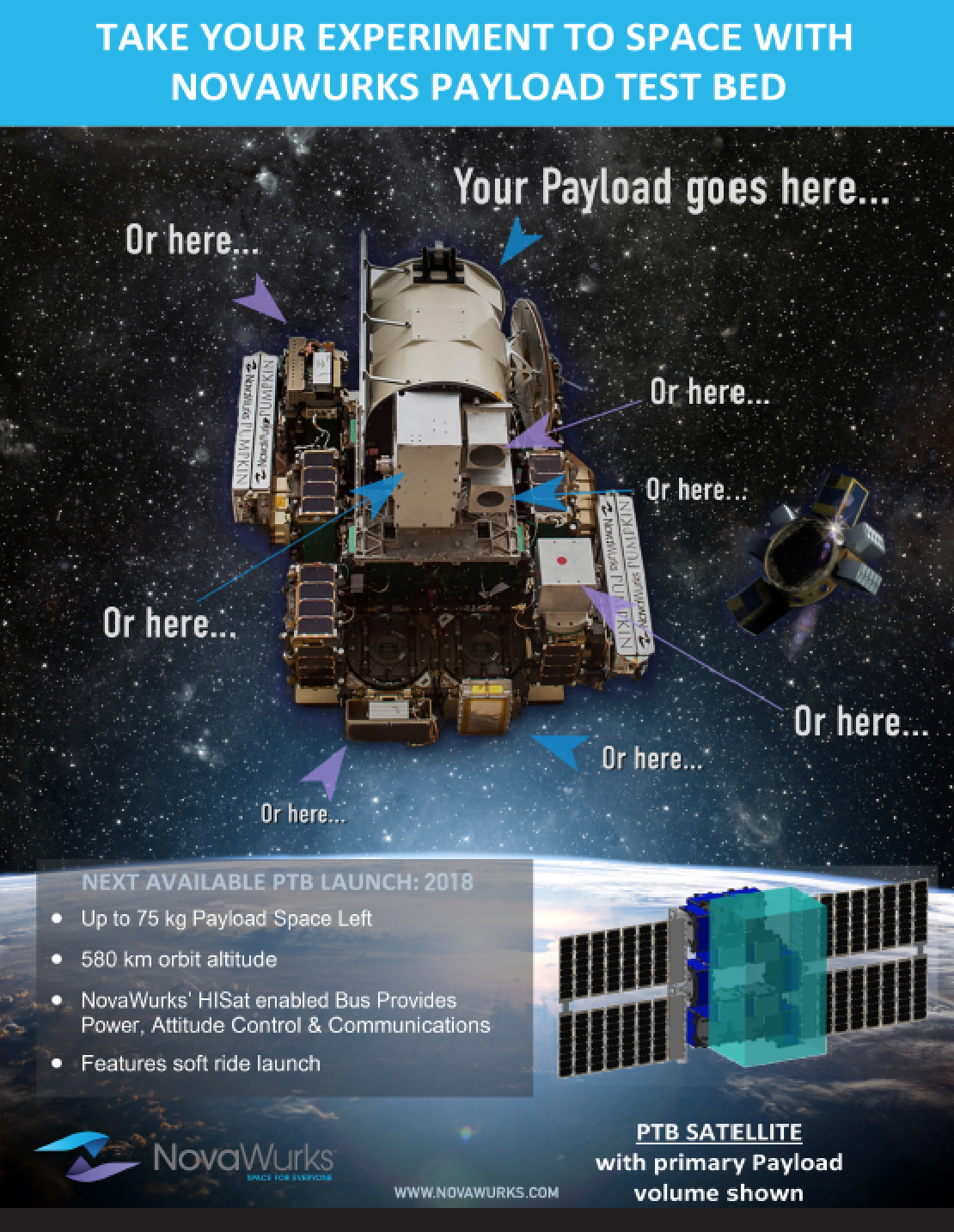The NEP Certification pathway will address aerospace engineers and experts and will be recognized by major space companies, organizations, foundations and agencies.

Many industries are going to work with KSF Space to review the content of the course material and accredit the certificate by recognizing NEP Certification as the world’s first and only smallsat engineering professional course.
One example of an aerospace company in the US that recognizes the NEP Certificate is Interorbital Systems in California—that firm aims to develop simple, yet robust technology to become the lowest-cost launch provider in the commercial space industry. Interorbital Systems is currently engaged in building a launch vehicle for the Google Lunar X Prize and for commercial launches.
Another aerospace company in US who recognize the NEP Certificate from KSF Space is Exos aerospace, a company that has taken the skills acquired from more than a decade of practical lessons learned, and millions of dollars worth of development and flight experience gained by the KSF Space team, and moved into the commercial space race—Exos Aerospace has fulfilled multiple contracts with NASA.
NEP recognition
NEP Certification will come to the market early this year and will be totally concentrated on the smallsat market sector. The benefits of being NEP Certified include...
• Recognizes space engineering skills across the globe: an NEP credential is a perfect addition for all aerospace engineers
• Noting smallsat skills to international employers: an NEP credential will become globally recognized and required—becoming NEP certified helps the aerospace engineering companies world recognize needed skill sets
• Reveals the ability to handle challenging complex satellite projects: the NEP exam eligibility criteria are based on a space engineering education and experience. A credential proves these skills and experience by successfully completing challenging and crucial industry-based aerospace and smallsat projects.
The certificate program will be divided into two major criteria:
1. NTP NanoSatellite Technical Professional Certificate for VET (Vocational Education Training)
2. NEP NanoSatellite Engineering Professional Certificate (For Engineering and post graduate level)
Diversifying investment into academic and vocational education provides more options for training, meeting the needs of a more diversely skilled youth. Moreover, in the long-term, more widespread levels of education are associated with increased tax revenue and lower levels of unemployment. There is also some, albeit limited, evidence linking education to health care savings and a reduction in crime.
Individuals typically earn more after undergoing vocational training. The gains for level 3 qualifications or apprenticeship can be as much as a 20 percent increase in average wages and a 14 percent increase in employment prospects.
Level 2 qualifications remain primarily a stepping stone to level 3 qualifications, in terms of improving career prospects.
In the near future, the importance of vocational training for the economy may rise as demographic shifts and technological advances affect the industrial landscape. The aging population is projected to require an increase in vocational positions, especially in sectors such as the smallsats industry. These are positions that cannot be easily replaced by machines, and they require need young, healthy, skilled workers in order to be filled.
KSF Space initiative was basically addressing VET sectors and working to encourage developing countries to build better futures for their nations by gaining such accredited certificates. KSF Space is currently seeking potential partners (foundation, universities, organizations and private sectors) to support this global initiative.
An NEP Certificate will be globally recognized and accepted and will assist in ensuring better job opportunities in the satellite industry in the future. Many future jobs will have a mandatory requirement of an NEP certification—if some satellite /telecom / electronics engineers are not NEP certified, they may not be qualified for the position, no matter how many years of experience they may possess.
Being NEP Certified means...
• You will have chances for collaborating and networking with other NEP professionals around the world, which can certainly increase your chances of professional success and development.
• You will be ahead of other NEP professionals, in terms of nanosatellite engineering knowledge as well as its application in the field of nanosatellites.
• Attaining a NEP Credential, you can reach out to potential employers from across the globe.
• There will be a great demand for the NEP certified employees.

Also, KSF Space is working with academic sectors across the globe to manage and help them write proposals and to then submit them to KSF Space’s Amateur Radio partners to win a scheduled event for a direct and live communication with the crew of the International Space Station (ISS).
KSF Space will enable students to chat directly with crew members of the ISS and will encourage them to engage in various discussions of science, technology and engineering. Radio organizations and space agencies in the USA, Russia, Canada, Japan and Europe sponsor this educational opportunity by providing the equipment and operational support to enable this direct communication via Amateur Radio. Hundreds of Amateur Radio operators around the world work behind the scenes to make these educational experiences possible.
According to Said Dr. Kayyali Mohamed, the founder of KSF Space, the company works with all universities and academic sectors that are interested in such experiments and will support and guide them in writing their proposal and off the guidelines for managing winning proposals.
In addition, KSF Space announced they will assist universities and academic aerospace, engineering and telecommunication departments to train students on how to construct and build smallsat (CubeSat) Ground Segment (GS) in order to track missions such as the QB50 initiative.
Finally, KSF Space will also announce the world’s first initiative between universities globally to kick off an R&D project for smallsat “Developing Bid Data Integrated System Approach for NanoSatellites,” with more than three universities having already signed a contract with KSF Space for Ph.D. and Master degree research collaboration—the project should start by mid-2017.
ksf.space
KSF Space was initially founded to enable cost-effective access to LEO with zero-environmental impact flying solutions. The foundation offers access to near-space and LEO for research and scientific experiments in many fields, such as Earth or Space Observation, biological testing, satellite positioning detection, Earth magnetic field measurement, radio transmission, atmospheric science and technology experimentation. The foundation encourages universities to develop R&D missions using smallsats, as these tiny spacecraft have become one of the most important elements in developing future scientific space missions.
Late last year, KSF Space Foundation signed a Memorandum of Understanding (MOU) with Interorbital Systems (IOS), wherein the latter firm will identify launch opportunities as well as provide associated pre-launch support for KSF missions.
According to IOS, by mid-2017/early 2018, the firm will initiate launch services for smallsats to a circular, polar orbit at 310 km altitude. Their current manifest numbers 135 smallsats awaiting launch.
Interorbital Systems has developed a simple, robust rocket technology that will enable that firm to be the lowest-cost launch provider in the commercial space industry. Interorbital Systems is currently engaged in building a Moon rocket, NEPTUNE 8 LUNA (N8), for the Google Lunar X Prize Team SYNERGY MOON and other NEPTUNE rocket-series variants, such as the N3, and N5 for commercial satellite launches.
KSF Space was initially founded to enable cost-effective access to LEO with zero-environmental impact flying solutions. The foundation offers access to near-space and LEO for research and scientific experiments in many fields, such as Earth or Space Observation, biological testing, satellite positioning detection, Earth magnetic field measurement, radio transmit, atmosphere science and technology experiment.
The foundation encourage universities to develop R&D missions using smallsats as these tiny spacecraft have become one of the most important elements in developing future scientific space missions.


